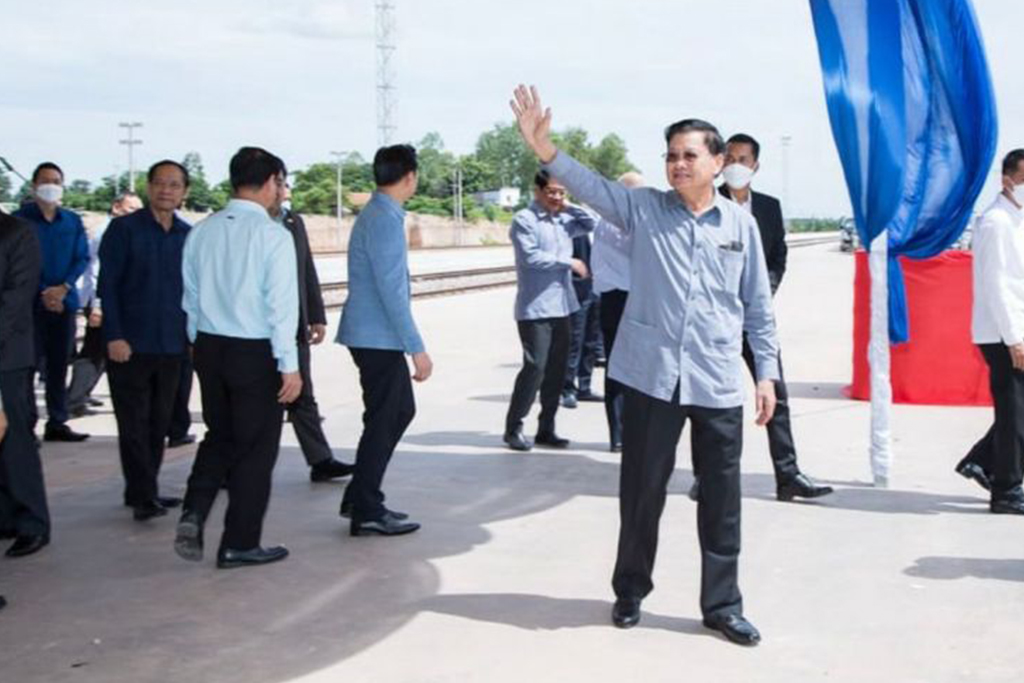
ການລົງຢ້ຽມຢາມ ທ່າບົກທ່ານາແລ້ງ ຂອງ ທ່ານ ທອງລຸນ ສີສຸລິດ ປະທານ ປະເທດ ແຫ່ງສປປ ລາວ
President pushes for logistics links driven by Vientiane Logistics Park

Party Secretary General and President Thongloun Sisoulith has called for state authorities to work with Vientiane Logistics Park (VLP) executives to further streamline operations so that Laos becomes a regional logistics hub.
The leader made the suggestion on Wednesday during his visit to the country’s first-ever integrated logistics park.
Welcoming the president and his entourage, the Chairman of Vientiane Logistics Park Co., Ltd., Mr Chanthone Sithixay, said the VLP, which includes the Thanaleng Dry Port, has greatly bolstered the efforts of landlocked Laos to become a land link.
Open for services since December 4, 2021, the VLP and the dry port have provided cost-effective services for the shipment of products to regional markets and beyond.

The chairman said his team has been working to further streamline logistics, including procedures that require cooperation and support from state authorities.
He told the president that his company has signed a deal with its Chinese partners to set up China’s Sanitary and Phytosanitary (SPS) and China Certification and Inspection Group (CCIC) representative offices at the Thanaleng Dry Port, to issue the necessary certificates.
SPS and CCIC certification will significantly streamline logistics and the transport of freight from neighbouring Thailand and beyond to China via Laos by rail, as goods will no longer need to undergo SPS inspection at the Laos-China Boten-Mohan border crossing.
The Lao investor has also signed deals with Thailand’s Laem Chabang seaport and a dry port in Kazakhstan, in a joint effort to streamline logistics and speed up the shipment of containers.
The Vientiane Logistics Park will pave the way for a surge in trade between China and Laos, as well as transit trade between China and Thailand, Malaysia, and Singapore.
Since its inauguration, the VLP has recorded increasing usage, notably the shipment of freight between Thailand and China, thanks to the facilitation offered by the Laos-Thailand and Laos-China railways, which both connect to the Vientiane Logistics Park.
The VLP and the railways offer cost-effective logistics and transport services, which enable containers to reach European markets within about 14 days. This is much shorter than transport by sea, which takes about 45 days.
Mr Chanthone told the president that the VLP will bolster Laos’ efforts to become a “Land Link Transit Transport Services’ provider for the sub-region, saying Laos will become “a gateway to link Asean with Asia and Europe”.
It is estimated that about 5 million containers will be shifted through Laos each year until 2030, with 2 million containers a year to be moved through the Thanaleng Dry Port and railways, according to the chairman, citing market research undertaken by the project’s consulting firm, Royal HaskoningDHV.
The Netherlands-based consultancy firm, which has conducted logistics surveys for seaports in Hong Kong, Singapore and Dubai, was hired to design the Vientiane Logistics Park and dry port.
Based on this estimation, the VLP is projected to generate about US$400 million (US$200 from each of the 2 million containers) of direct revenue into the state budget.

In addition, the US$727 million VLP being developed on 382 hectares of land is offering investment opportunities to drive the economy and generate indirect income for the state.
Mr Chanthone is eyeing European investors, who might consider doing business here with respect to repackaging their products given that improved infrastructure, cost-effective transport, and the Asean free trade zone would make Laos very attractive.
“Vientiane will become a centre for goods processing,” he said with optimism.
Other zones with investment potential are the Tank Farm – a fuel distribution centre for Laos, a Free Trade Zone, and an Export Processing Zone.
The Vientiane Logistics Park is part of the Lao Logistics Link project, which also includes Vung Ang Port in Vietnam’s central Ha Tinh province, and a planned railway to link Vientiane with the seaport. Through this route, containers would reach countries in the Pacific region, according to the chairman.
President Thongloun congratulated the developer for the sound progress made in realising the project. He called for the relevant ministries to work with the project in order to facilitate its operation and formulate the necessary legislation on logistics to better regulate the industry.
The leader told his entourage to ask the government to consider forming a taskforce to oversee logistics affairs, including drafting a logistics development strategy in response to a proposal made by Mr Chanthone


